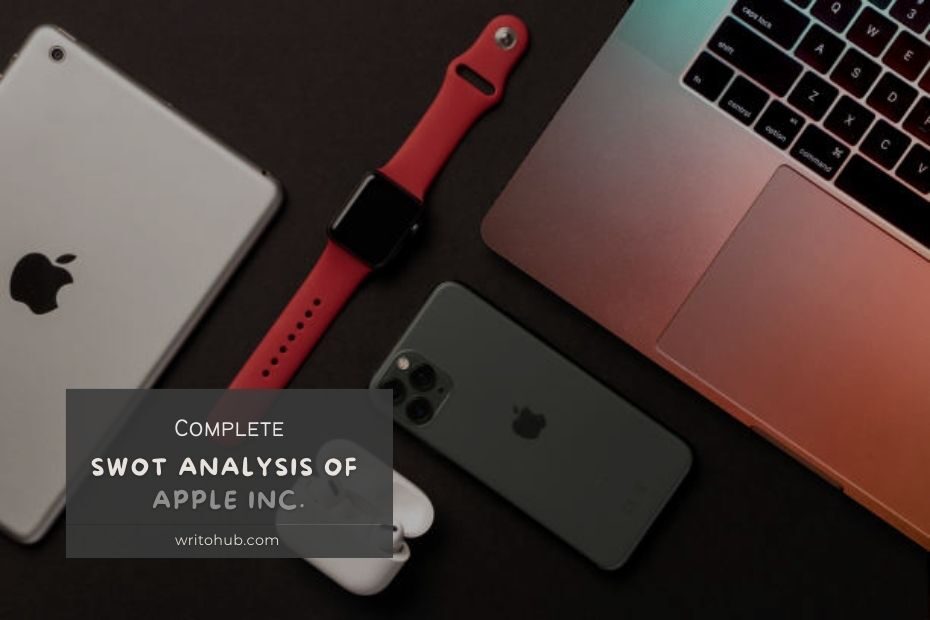Apple Inc., one of the world’s most iconic technology companies, operates in the fiercely competitive consumer electronics and software industry.
A SWOT analysis of Apple reveals its strengths, weaknesses, opportunities, and threats, providing insights into its strategic position in the dynamic market.
Strengths in the SWOT Analysis of Apple
- Strong Brand Image: Apple’s brand is synonymous with innovation, quality, and luxury, fostering intense customer loyalty and driving premium pricing.
- Innovative Product Portfolio: Apple consistently introduces groundbreaking products and technologies, setting industry standards and maintaining a competitive edge.
- Ecosystem Lock-In: The Apple ecosystem, including iOS, macOS, and iCloud, locks users into its services, enhancing customer retention and cross-selling opportunities.
- Retail Presence: Apple’s retail stores provide a unique, immersive customer experience and contribute to robust sales and customer support.
- Robust Supply Chain: The company’s efficient supply chain management ensures timely product launches and minimizes inventory costs.
Weaknesses in the SWOT Analysis of Apple
- High Pricing: Apple’s premium pricing strategy limits its market share in price-sensitive segments, potentially missing out on large customer bases.
- Dependency on iPhone: A significant portion of Apple’s revenue is derived from the iPhone, making the company vulnerable to shifts in the smartphone market.
- Supply Chain Vulnerabilities: The company relies heavily on suppliers in Asia, which can lead to supply chain disruptions, as seen during the COVID-19 pandemic.
- Lack of Diversification: While expanding services, Apple’s revenue remains heavily dependent on hardware sales, particularly the iPhone.
- Environmental Concerns: Apple faces scrutiny regarding its environmental impact, including e-waste and carbon emissions, which can affect its reputation.
Opportunities in the SWOT Analysis of Apple
- Services Growth: Expanding its services, such as Apple Music, Apple TV+, and Apple Arcade, can diversify revenue streams and enhance customer engagement.
- Wearables and Healthcare: Capitalizing on the growth of wearables like the Apple Watch and exploring opportunities in healthcare can open new markets.
- Emerging Markets: Further penetration into emerging markets like India and Africa offers substantial growth potential.
- Sustainability Initiatives: Strengthening sustainability efforts can align with consumer values and regulatory trends.
- Augmented Reality (AR): Investing in AR technologies and applications can drive product innovation and open new markets.
Threats in the SWOT Analysis of Apple
- Competition: Intense competition from rivals like Samsung, Google, and Chinese smartphone manufacturers can erode market share and margins.
- Market Saturation: The smartphone market is approaching saturation, leading to slower upgrade cycles and increased competition for existing customers.
- Regulatory Scrutiny: Apple faces regulatory challenges related to antitrust concerns, privacy, and its app store practices, which can lead to legal and financial consequences.
- Supply Chain Disruptions: Ongoing supply chain disruptions, geopolitical tensions, and trade disputes can impact production and product availability.
- Cybersecurity Risks: The company is a target for cyberattacks and data breaches, posing risks to customer privacy and data security.
Conclusion
Apple’s SWOT analysis underscores its position as a tech giant known for innovation and premium products.
To maintain and enhance its market presence, Apple must leverage its strengths, address weaknesses, seize opportunities, and mitigate threats while adapting to changing consumer preferences, regulatory environments, and competitive dynamics in the ever-evolving tech industry.
